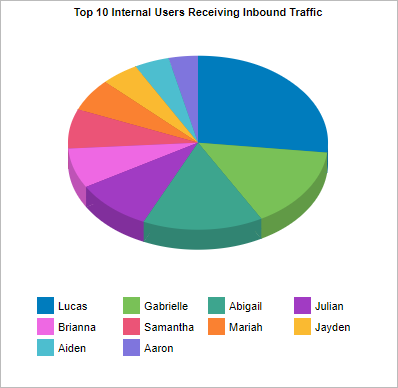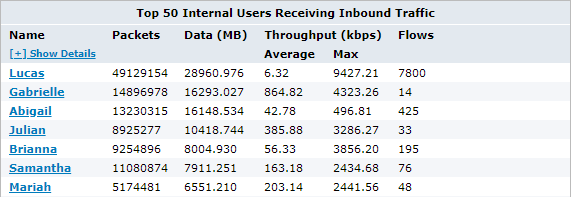Monitoring network users
The Users report shows the top users by data volume for a selected time period. Inbound and outbound traffic are reported separately. You can view internal and external users in the report, answering questions such as:
- What internal users are the top talkers and top listeners?
- Which external users are top talkers?
- Which external users are top listeners?
- Is one user choking the network?
Using this information, you can determine if you need to create policies for these high data volume users. You may want to create protection policies for your important users, like your CEO or finance department, or create control policies to limit users who are abusing the network.
In this report, users are associated with IPInternet protocol addresses. Network traffic flows from one host to another and typically, one host is considered internal to your network while the other is considered external.
Hosts that fall into a network object defined as internal are considered internal to your network. Hosts that fall into a network objecta logical definition created and stored in the Exinda lilbrary, can represent any network component defined as external are considered external to your network. Keep in mind that the traffic is inbound and outbound relative to your LANLocal area network – not relative to the host or user. Inbound traffic for an external user means a user was sending data into your network.
You can drill into the user by clicking on the user name in the tables below the charts. This will show the Applications Report for the user that you drilled into. You can then use the selector on the Applications report page to show URLs or conversations or hosts that involved the user.

The Users report displays traffic volume by user.
The tables at the bottom of the report shows for each of the top users, the total amount of data, and the maximum and average throughput rates, the number of packets, and the number of flows for the selected time period. More network metrics, such as, round-trip time (RTT), network and server delays, and TCPTransmission Control Protocol efficiency can be shown by clicking on the Show Details link in the tables.

The table on the Users report shows traffic volume metrics broken down by user.
To access this report:
- On your browser, open the Exinda Web UI (
https://Exinda_IP_address). - Key-in the User and Password.
- Click Login.
- Go to Monitor > Users.
To show only internal users or external users, use the Select Users to View selector at the top of the page.
To interact with the pie-based reports, you can hover over the pie slices to view the amount of data transferred as well as view the percentage of the pie. Note that the pie is showing only the top items, so the proportion is relative to the top items - not relative to all the traffic through the appliance. That is, if one wedge showed 50% of the traffic, that means it is 50% of the top items, not 50% through the appliance.
- To understand how to set the desired time range for a chart, see Setting the Time Range.
- To understand how to drill into the data to find particular filtered data, see Drilling into the Data.
- To understand how to print the report or schedule the report, see Printing and Scheduling Reports.
Monitoring reports can be exported as a PDF document, saved as a scheduled report, or can be printed directly from the Web UI. For more information refer to Exporting, printing and scheduling reports.